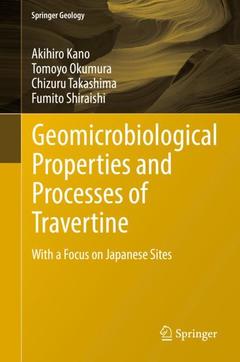Geomicrobiological Properties and Processes of Travertine, Softcover reprint of the original 1st ed. 2019 With a Focus on Japanese Sites Springer Geology Series

1. Introduction
2. Basic knowledge of geochemical processes
3. Sedimentology of travertine4. Methods
5. Geomicrobiologial processes for laminated textures6. Geochemical model for rapid carbonate precipitation of travertines
7. Travertines in Japan7.1. Futamata
7.2. Okuokuhachikuro7.3. Yunomata
7.4. Shionoha7.5. Kibedani
7.6. Nagayu7.7. Anraku
7.8. Shiobitashi8. Concluding remarks
Professor Akihiro Kano is the head of the Laboratory of Historical Geology in the Department of Earth and Planetary Science, The University of Tokyo. He researched carbonate sedimentology during his master’s degree study at Tohoku University and his doctoral study at Stockholm University in 1990. While he was working at Hiroshima University (1990–2008), he did intensive research of the sedimentology and geochemistry of freshwater carbonate deposits, or tufas. He started his research on travertines in 2003, and one of his early studies with Dr. C. Takashima successfully revealed that travertine lamination occurred daily. His appointment at Kyushu University in 2008 activated his travertine studies on the island of Kyushu, where a number of hydrothermal sites produce travertine. He moved to The University of Tokyo in December 2016. In addition to travertines and tufas, he is currently working with projects on stalagmite paleoclimatology, gas hydrates in the Japan Sea, and Ediacaran carbonate deposits in China and Brazil.
Dr. Tomoyo Okumura is an assistant professor at the Center for Advanced Marine Core Research, Kochi University. Before taking up her current position, she worked at Kyushu University, The University of Tokyo, and the Japan Agency for Marine–Earth Science and Technology (JAMSTEC) as a postdoctoral fellow. She has made significant contributions in the geomicrobiology of modern carbonate sediments at hot springs in Japan, Indonesia, and the U.S.A. Dr. Okumura is interested in understanding how microbes contribute to or are associated with microbialites such as stromatolites, thrombolites, and fenestrate microbialites. She applied molecular biological techniques, geochemical analysis, and fluorescence staining for the carbonates. Her current research topics extend to deep-sea sediments in order to understand microbe–sediment interaction in aphotic chemosynthetic environments.
Dr. Chizuru Takashima is an associat
Focuses on important geochemical principles for understanding travertine
Draws attention to the important features of travertine that can be broadly applied to other geological phenomena
Is rich in examples of Japanese hot springs
Date de parution : 10-2018
Ouvrage de 176 p.
15.5x23.5 cm
Date de parution : 01-2019
Ouvrage de 176 p.
15.5x23.5 cm



